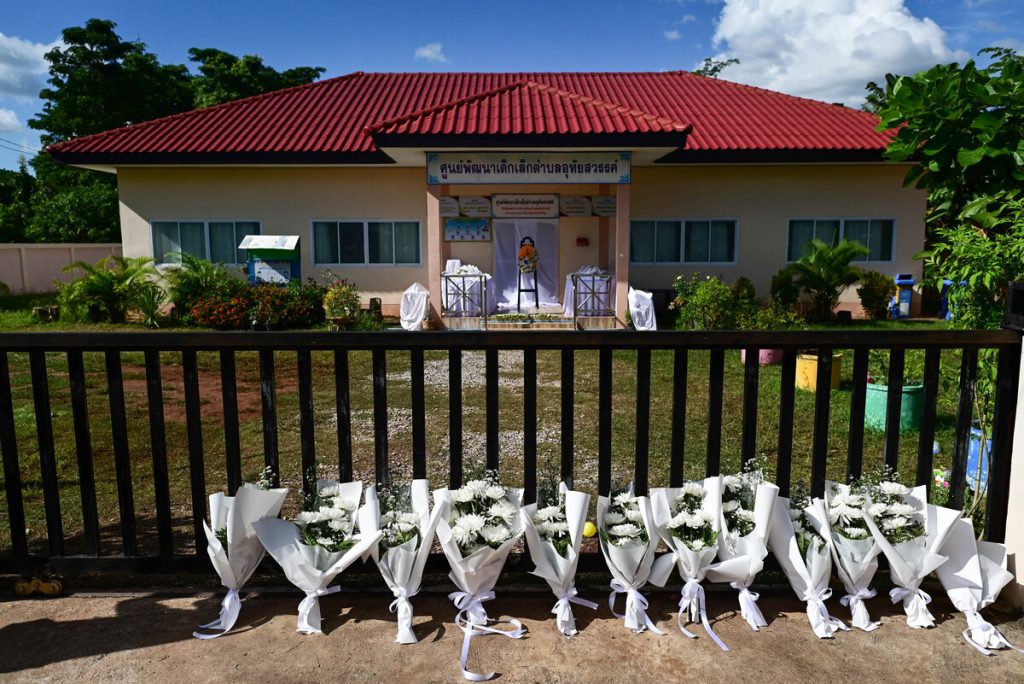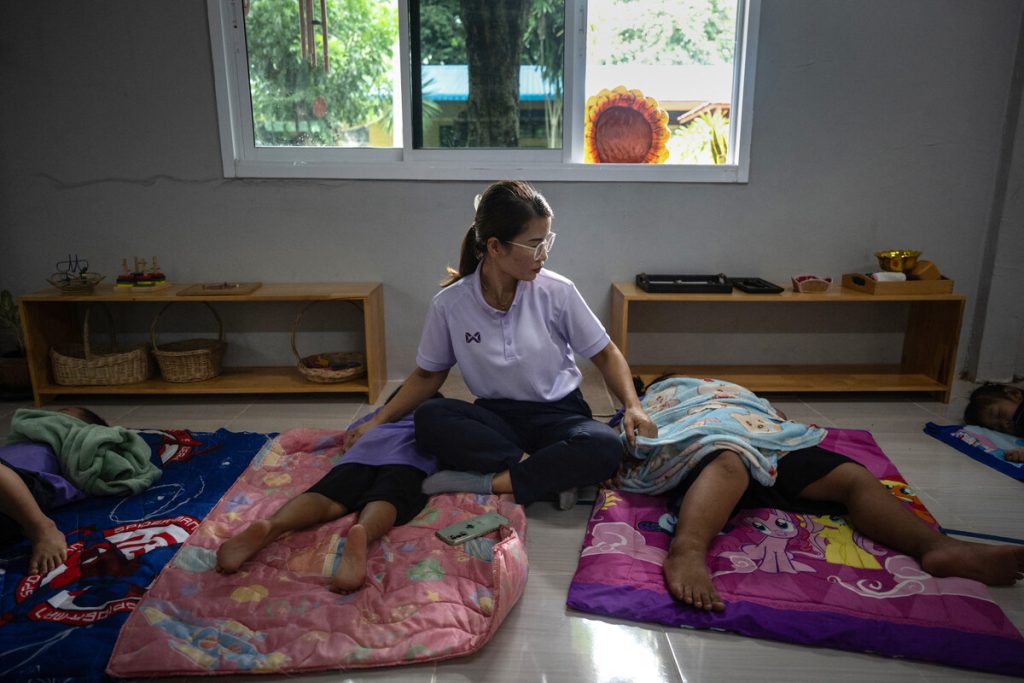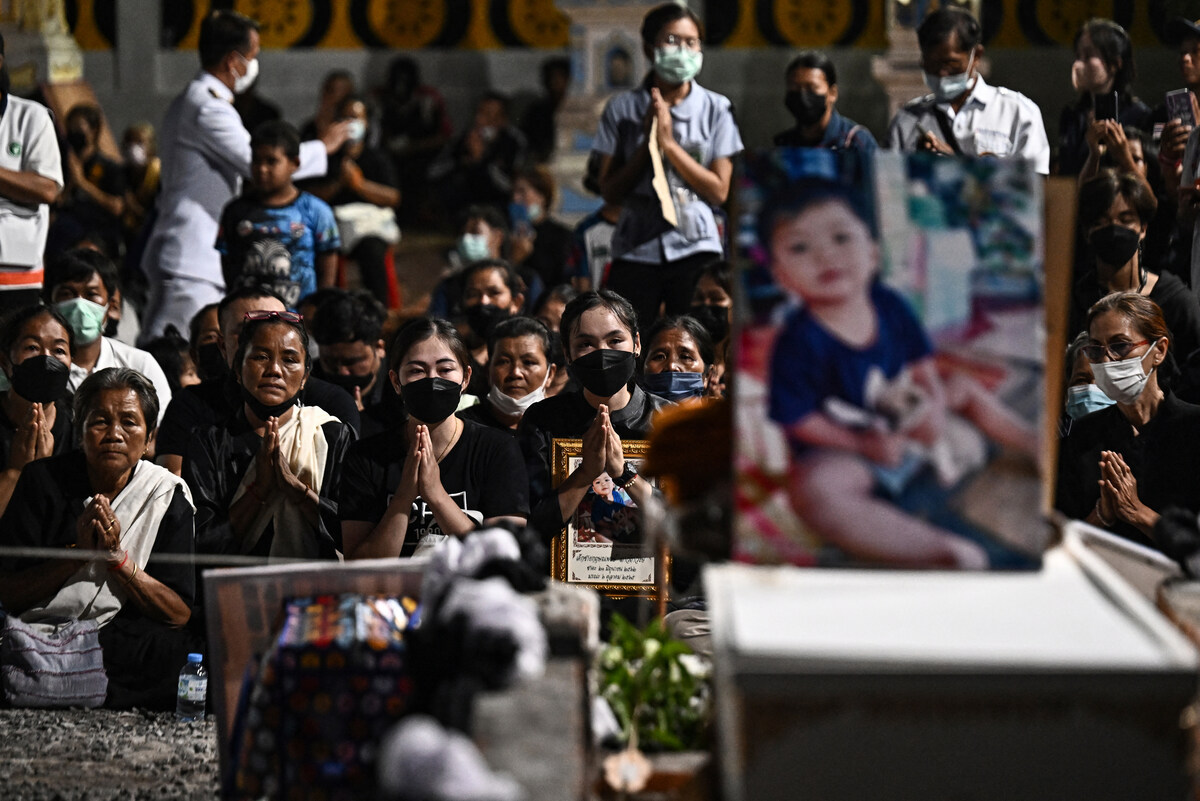Clutching a well-worn teddy named “Little Bear”, Paweenuch Supolwong fiddles with Buddhist amulets hanging heavy on her neck as her grandmother tells of the trauma still afflicting the four-year-old.
Paweenuch, known by the nickname Ammy, was one of only two children to survive a massacre at a Thai nursery a year ago that killed 36 people and devastated the close-knit rural village of Uthai Sawan.
Now when she plays, she is watched via CCTV — at home and nursery — to reassure her family.
“I’m still terrified,” Paweenuch’s grandmother Yupin Srithong told AFP, saying she did not want to send her back to school.
“I don’t want to let her out of my sight.”
During the children’s nap on October 6, 2022, ex-police officer Panya Khamrab forced his way into the nursery.
With a knife and a gun, he slaughtered 12 adults and 24 children, all but one aged five or under, before killing himself to end one of the deadliest massacres in the kingdom’s history.
Asleep under a blanket, Ammy miraculously survived, but the attack still haunts her.
Loud bangs frighten her, Yupin said.
“She’ll say ‘there’s shooting again’ and she’ll then ask me to hug her.”
Uthai Sawan — which translates roughly as “heaven” — is about 500 kilometers (300 miles) north of Bangkok in Nong Bua Lam Phu province, one of Thailand’s poorest regions.
Like many families in the area, Ammy’s parents have moved for better-paid work in Bangkok, leaving her grandparents to look after her.
At Yupin’s home, a shiny white camera stands out starkly on the old wooden ceiling. Her mother installed it after the attack so she could keep watch from afar.

Drug battle
Outside the single-story nursery with peach-colored walls, toys, and slides litter the cropped grass but the doors remain taped shut.
It is not clear what will happen to the building, though the ground has been staked out for a new nursery barely 250 meters (820 feet) away.
A permanent memorial was “in discussion”, local official Danaichok Boonsom told AFP.
For now, Ammy and her friends play at a temporary nursery — overlooked by a giant TV screen showing images from cameras monitoring every entrance to the compound.
“They feel safe and at peace,” said Nanticha Punchom, the head of Uthai Sawan Child Development Centre, who was at the nursery when the attack happened.
“I have to tell myself that it’s already over and try not to think more about it,” she told AFP.
“The CCTV cameras make me feel safer.”
While Panya’s motive for the slaughter has never been established, the case evoked a host of demons that haunt Thailand — drugs, abundant firearms, and wealth inequalities.
Panya was known as a regular user of methamphetamine — the highly addictive stimulant that is a scourge throughout Southeast Asia — and was sacked from the police for drug abuse.
Thai Prime Minister Srettha Thavisin, due to visit the village in November, has vowed to end methamphetamine abuse, but with street prices at record lows in 2022 he faces a tough battle.

‘Open wound’
After the attack, financial aid flooded into the district, much of it directed to bereaved families, and psychological help was offered as people tried to rebuild their lives.
Banyen Scrichanil, whose three-year-old grandson Nannaphat was among the dead, used some of the payout to renovate their home.
Gone are their home’s wooden walls, scuffed floors, and children’s toys. Banyen’s sobs echo against new white tiles and freshly painted walls.
“I miss him every day. I dream about him every day,” said the 58-year-old.
“I see his face all the time. To think or talk about him makes me tear up,” Banyen said as her husband Kham Pornnikhom passed her tissues.
Behind them, a dark wood cabinet with toys and framed photographs of Nannaphat — known by his nickname Stamp — dominates the empty room.
“It’s like there’s an open wound,” she said.
Virtually everyone in the village has a connection to one of the bereaved families, with the whole community blanketed by grief.
‘I miss you’
Stamp’s grandfather Kham said they talk about him daily, but some families wanted to leave the massacre in the past.
“If you talk about the incident then they will say it’s hurtful and it’s better not to mention it,” he said.
Their neighbors had urged the couple to move on.
“But they’re not the ones who lost someone so they can talk like that,” said Banyen, scrolling through photos and videos of her grandson.
Just for a minute, the empty house is filled with noise from the videos.
“Beep beep!” Stamp yells as he rides a small bike around the home.
Everyday moments — him brushing his teeth, slapping his bare belly after a bath, or showing the camera a grubby garden find — are replayed again and again on Banyen’s phone.
“Where are you right now?” Banyen asked as silence crashed back into the room.
“I miss you, Stamp.”







